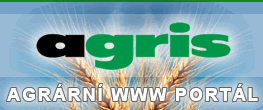WHEAT AS A SOURCE OF STARCH
09.12.1999 | Odborné konference
PŠENICE JAKO ZDROJ ŠKROBU
D. Marešová, J.Petr, I. Capouchová
Czech University of Agriculture in Prague
Department of Plant Production
165 21 Prague 6 - Suchdol
Souhrn
V pokusech s odrůdami ozimé pšenice byly zjištěny odrůdy vhodné pro produkci škrobu. Tyto odrůdy patří především do jakostní kategorie C, tedy odrůdy, které nejsou vhodné pro pekárenské využití a nebo do jakostní skupiny B (chlebové pšenice). Podle získaných výsledků nejsou pro škrobárenské využití vhodné odrůdy z jakostní skupiny E. Nejvyšším obsahem škrobu se vyznačovaly česká odrůda Siria a ze zahraničních odrůd odrůdy Versailles, Estica a Contra.
škrob, pšenice, odrůda, kvalitativní hodnocení, jakostní kategorie
Summary
In the experiments with varieties of winter wheat were determined varieties suitable for starch production. These varieties are first included in qualitative category C, which are not suitable to backing use and or in qualitative category B (bread wheat). By obtained results for starch production are not suitable varieties from qualitative category E. The gut results with the highest starch content in dry matter of grain had Czech variety Siria and foreign varieties Versailles, Estica and Contra.
starch, wheat, varieties, qualitative evaluation, qualitative category

The starch is after cellulose the second most spread carbohydrate in the nature. The starch is produced in green plants by photosynthesis assimilation from water, air carbon dioxide and action of the sun radiation. For human the starch was and still is one of the essential plant sources. This natural polymer represents base of population food in the whole world.
Plants, which contain starch represent own natural source potential. In this group of plants we can count corn, potatoes and cereals especially wheat. In the world is the most important source of starch corn. In Europe at present time increase importance of wheat as a starch raw material. During the last year the share of starch consumption was 62 % corn starch, 20 % wheat starch and 18 % potatoes starch in the countries of Europe Union. A great part of native starch and modified starch is used for non-food purposes in paper, textile and chemistry industry. For future are important ecological aspects of this natural raw material, as are degradable covers produced from starch.
Cereals contain 50 - 65 % a starch in dry matter. The question is why wheat? We can find some answers for this question:
1. Suitable and positive climatic conditions for intensive growing of wheat in Europe
2. Longtime not positive price of corn at world market and tendency of use own raw material sources
3. Problem local surplus production and possibility its solving, tendency of searching new trade outlets
4. Not low profit from sale vital gluten, which is very important co-product by wheat starch production

According to foreign experiences not only use of wheat in starch industry brings profit, but also use of suitable wheat variety. Our research is oriented to searching varieties suitable for starch production and influence of growth conditions on content and quality of starch.
During 3 years 1996 - 1998 we tested 10 wheat varieties grown in 5 - 7 different growing regions in Czech Republic on starch content.
Tested varieties: Hana, Samanta, Siria, Trane, Estica, Samara, Sida, Versailles, Contra, Šárka. Tested growing regions: Domanínek, Hradec, Lípa, Trutnov, Stachy, Nechanice,
Chrastava

For determination of starch content was used method by Ewers (ČSN 560512-16).
In the experiments varieties with higher starch content were: in 1996 : Siria, Samanta, Trane [Graf 1], in 1997: Siria, Samara, Versailles, Estica, Sida [Graf 2], in 1998: Siria, Estica, Contra, Versailes [Graf 3]. Globally in all experiments the highest content of starch had varieties Siria, Versailles and Estica. Very hopeful is also variety Contra. Starch varieties of wheat are included first in qualitative category C, which are not suitable to backing use and or in qualitative category B (bread wheat). Different results show out variety Samanta, which is included in qualitative category A. To starch use are not suitable varieties from qualitative category E. As example we can present variety Hana, which had in our experiments the lowest starch content in dry matter of grain.
Statistical evaluation our experiment was provided by analysis of variance. Influence of variety on starch content in dry matter of grain was statistically conclusive in 1997 by varieties Siria,Versailles, Hana and Samanta. In 1998 by varieties Siria, Hana, Šárka and other varieties were not statistically conclusive. Varieties Hana and Šárka had statistically conclusive the lowest starch content in dry matter. New variety Šárka is included in qualitative category B and was added to experiment in 1998 on base its hopeful results at experimental station Stupice.
Grant vznikl za finančního přispění výzkumného záměru MSM 412100002.
Kontaktní adresa:
Ing. Dana Marešová; ČZU Praha, katedra rostlinné výroby; 165 21 Praha 6 - Suchdol
Další články v kategorii Zemědělství
- Ministr Výborný na poslední Radě ministrů v roce 2025: Podpora inovací je pro budoucnost zemědělství zásadní (12.12.2025)
- Týden v zemědělství podle Petra Havla – č. 50 (12.12.2025)
- MŽP poskytne 300 milionů korun na instalace fotovoltaik na zemědělské půdě (12.12.2025)
- Regenerativní zemědělství se po letech pokusů i praxe jeví jako možné a vhodné (11.12.2025)
- Ministerstvo zemědělství vyhlásilo výsledky veřejné soutěže programu na podporu aplikovaného výzkumu ZEMĚ II (11.12.2025)
- Zemědělci by mohli nově řešit i větrnou erozi, MŽP připravilo novelu vyhlášky (10.12.2025)
- Podcast | Šebek: Nelžeme si do kapsy, že nová vláda bude podporovat malé a lokální farmy (10.12.2025)
- Agrostroj Pelhřimov se loni dostal do ztráty, chystá závod v USA (10.12.2025)
- Dohoda o NGT umožní rychlejší vývoj plodin odolných vůči klimatu (10.12.2025)
- Chlebovické brambory – Farma Libora Janečky – vítěz soutěže Farma roku 2025 (10.12.2025)

 Tweet
Tweet





